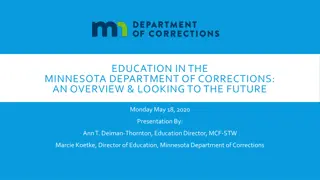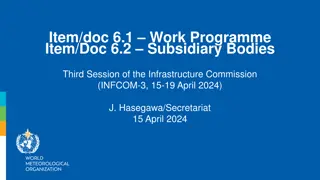
Understanding Patent Examiners and the USPTO
Learn about patent examiners, patents, and the USPTO. Discover the process of obtaining a patent and the key criteria inventions must meet. Explore the role of patent examiners in evaluating patent applications.
Uploaded on | 0 Views
Download Presentation

Please find below an Image/Link to download the presentation.
The content on the website is provided AS IS for your information and personal use only. It may not be sold, licensed, or shared on other websites without obtaining consent from the author. If you encounter any issues during the download, it is possible that the publisher has removed the file from their server.
You are allowed to download the files provided on this website for personal or commercial use, subject to the condition that they are used lawfully. All files are the property of their respective owners.
The content on the website is provided AS IS for your information and personal use only. It may not be sold, licensed, or shared on other websites without obtaining consent from the author.
E N D
Presentation Transcript
What Is a Patent Examinerand Where Do They Come From?* By Daniel Chappell *Disclaimer: Everything presented herein (whether presented orally, in writing, or by any other means) is my own opinion and does not in any way represent the opinion of the United States Patent and Trademark Office (USPTO) about, on, or regarding anything and does not in any way bind the USPTO. I am not an attorney, so nothing said or presented herein creates any kind of protected relationship (e.g., an attorney-client relationship or an agent-client relationship). Everything I say or present is my own thinking or opinion.
What Is the USPTO? The USPTO is headquartered in Alexandria, VA, and oversees the issuance of patents (which is the side of the USPTO I work in) and trademarks (the other folks at the USPTO). Article 1, section 8 of the United States Constitution states The Congress shall have Power To promote the Progress of Science and useful Art, by securing for limited Times to Authors and Inventors the exclusive Right to their respective Writings and Discoveries The USPTO is the agency created by Congress and given the task of issuing patents and trademarks to secure the rights of Authors (trademarks) and Inventors (patents) a limited monopoly for their works.
Whats a Patent? A patent is a time-limited right to exclude others from making, using, selling, or importing for sale whatever you ve patented. A patent is a monopoly granted for 20 years (from the date you file your application) in which you are the only person authorized to make/use/sell/import for sale your patented invention. In exchange for your time-limited monopoly, you have to tell people how to make and use your invention (the quid pro quo ). This is how generic medications often work: someone gets a patent for a new medication, and when the patent on that new medication expires, someone else uses the patent s instructions to make that medication and sell it (usually for a lot cheaper). A patent is not a guaranteed ticket to a pile of money! What usually happens is someone gets a patent for something and then licenses that patent to someone else to make, use, sell, or import for sale whatever that someone s patent is for in exchange for a cut of the profits.
SoHow Do You Get a Patent? This is where Patent Examiners come in. To get a patent, the thing that you ve claimed to have invented has to be: Eligible for a Patent: you can t patent something that s naturally occurring (e.g., a chunk of rock containing cobalt), but you could patent a new and useful way to change something that occurs naturally (e.g., a new way to extract cobalt from that chunk of rock and then refine the extracted cobalt to create ultra-pure cobalt); New: novelty is the correct term, which means no one else has patented or previously done exactly what you ve claimed to have invented (this is covered by 35 U.S.C. 102); Inventive: non-obviousness is the correct term, which means that your invention has to be different from a reasonable combination of things other people have previously invented. For example, you probably couldn t patent a different way to tape a box because someone s already invented a box and tape, and it d be obvious to combine the box and tape because you d want stuff to stay in the box (non-obviousness is covered by 35 U.S.C. 103); and Clearly Described: in exchange for your time-limited monopoly, you have to clearly explain what your invention is, how people can make it, and how people can use it (this is covered by 35 U.S.C. 112) so that anyone can make use your invention after your patent expires. There are usually a few other hoops to jump through, but those are the Final Four.
Random Facts About the U.S. Patent System The way 35 U.S.C. 102 and 103 are written, Coca Cola cannot get a patent for their formula for Coke because Coke has been in public use for more than a year; they ve chosen the trade secret route. A trade secret doesn t give you a time-limited monopoly; you can keep your monopoly for as long as your trade secret remains a secret The United States was unique among other countries in the world because we were a first to invent country: if someone else stole your idea and got a patent, if you could prove that it was your idea before filing and that you d diligently worked on it, their patent could be awarded to you. The first 10,000ish patents issued by the U.S. were all issued before 1790; unfortunately, all of them were lost in a fire in 1836. Those patents are known as the X-patents.
A Day in the Life of a Patent Examiner Each day, I take a look at my docket of patent applications (next three slides). The USPTO uses a production system in which I m given a set number of hours, based on my grade level, to examine a patent application. That means I have a certain amount of time to read the application, understand what the new and cool invention is, and perform a search to see if I can find the exact same thing (then the invention lacks novelty and is anticipated ) or if I can find a few things that can reasonably be put together to yield the invention (and then it s obvious ). Once I ve found one or more things that have already been done before the filing data of the patent application I m examining ( prior art ), I write an Office action explaining my findings to build a case for the rejection. If I don t find anything to anticipate or render the invention obvious, I send an allowance instead of a rejection. The applicant (or their attorney) reads my findings, often gives me a call to discuss them, and then files an amendment in which they usually change the wording of their claims in view of the prior art I found. I then consider their amendments and either allow their application to issue as a patent or send them a final rejection. If I allow the application, they pay a fee and get their patent. If I send them a final rejection, they can either pay the USPTO for another round of prosecution of their application or appeal to a higher authority than the Patent Examiner. If they opt for an appeal, they can appeal to an administrative tribunal at the USPTO or go straight to the U.S. Court of Appeals for the Federal Circuit. If they lose again at the Federal Circuit, they can appeal to the Supreme Court. It s kinda neat to know that my rejections are only two steps away from Supreme Court review!
Some Important Skills to Become a Patent Examiner Education: a bachelor s degree (or higher) in a scientific or engineering discipline is required. No legal/patent experience is needed; the USPTO trains incoming Examiners in the basics of patent law. Example: I ve got a bachelor s in chemistry and computer science and a masters in CS (I ve got no legal/law school experience). Ability to Quickly Learn New Concepts: since you re figuratively over the horizon with new technology, you ve got to be able to quickly learn and understand new technological concepts so that you can apply those new concepts to current patent applications. Another example: I work in computer memory and cache architecture; my masters focused on computer architecture, but I had no idea how flash memory works when I got my first flash memory application, so I had to learn the technology while simultaneously examining my first flash memory application. Attention to Detail: since novelty and non-obviousness aren t the only hoops to jump through to get a patent, you ve got to be able to read critically and make sure that someone who s applied for a patent has clearly explained an invention s inner workings so that other people can make and use their invention after their patent expires.
Some Other Important Skills to Become a Patent Examiner Ability to Write: since you ve got to write a report on your findings, you need to be able to clearly express complex concepts in writing. Ability to Manage Time and Meet Deadlines: with the production system, you ve got to be able to do everything previously mentioned while meeting production deadlines and deadlines for responding to patent applicants. Ability to Work Cooperatively: patent examination can be a very independent, lone wolf type of job; however, you do get to work directly with patent attorneys and inventors to make sure that a good patent issues. It s best to keep things collaborative and collegial instead of adversarial. As written, the patent laws say [a] person shall be entitled to a patent unless That means that folks who apply for a patent are entitled to a patent; the job of a Patent Examiner is to be a gatekeeper to make sure the patent an inventor gets is for what they invented.
Any questions? Image Citations: USPTO logo/Dept. of Commerce Seal: https://www.airosmedical.com/airos-medical-granted-u-s- trademark-registration-for-company-brand-name/ USPTO Alexandria HQ Photo: https://living-in-washingtondc.com/closestmetro-uspto.php Issued U.S. Patent: http://www.mxlegal.com/issued-patents Lightbulb: http://clipart-library.com/light-bulb-image.html Trivia: https://princewilliamliving.com/celebrate-national-trivia-day-on-jan-4/ Patent Application Docket and Application Viewer and SEARCH: USPTO


